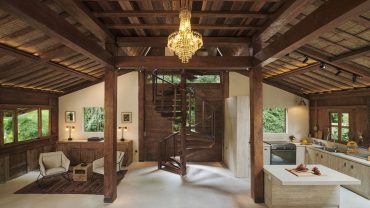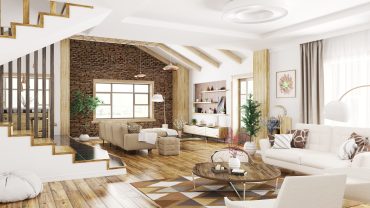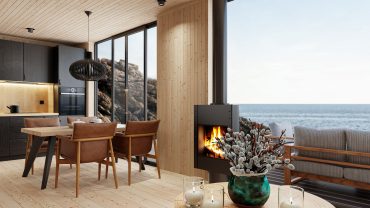Byzantine interior design conjures images of majestic domes, glittering mosaics, and lavish use of gold and precious stones.
Originating from the Byzantine Empire, which spanned from approximately 330 AD to 1453 AD, this interior style represents a fusion of classical Roman and Eastern influences. It played a pivotal role in shaping the aesthetics of Eastern Orthodox Christian architecture and art. So, what exactly characterises Byzantine house interiors? Read on for all the details.
The Origins of Byzantine Design

The architectural splendour of Hagia Sophia (Credit: Edith Polverini via Getty Images)
In 330 AD, Emperor Constantine I transferred the capital of the Roman Empire from Rome to the site of what is now modern-day Istanbul. There, he founded the city of Constantinople, marking the beginning of a distinct Eastern Roman Empire, which gradually diverged from its Western counterpart in language, culture, and administration. Constantinople’s citizens considered themselves Romans, but future generations would view them as the first members of a new Byzantine Empire. And its capital, Constantinople, also known as Byzantium, was a melting pot of cultures, blending Greco-Roman traditions with influences from the Near East and Christianity. It was here that the Byzantine interior style emerged.
With the architectural prowess of Rome but infused with Eastern ornamentation and spiritual symbolism, Byzantine decor was intended to reflect both the grandeur of the empire and the glory of Christianity. Churches, in particular, were adorned with elaborate decorations meant to inspire awe and convey theological messages. The use of space, light, and decoration in Byzantine interior style was carefully orchestrated to create an ethereal atmosphere that transcended the earthly realm.
Original Characteristics of Byzantine Interior Design

The rich opulence of a Byzantine-style house (Credit: Vostok via Getty Images)
Several key elements defined original Byzantine decor, each contributing to its distinctive and opulent aesthetic:
Grand Domes & Vaults
One of the most iconic features of original Byzantine architecture was the use of large domes and vaults. Structures like the Hagia Sophia exemplify this with their massive central domes, which seem to float above the space below. Such domes were often supported by pendentives or squinches, architectural solutions that transition from a square or octagonal room to the circular base of a dome.
Intricate Mosaics
Mosaics are perhaps the most celebrated aspect of Byzantine decor. Walls, ceilings, and domes were covered with intricate mosaics made from small pieces of coloured glass, stone, or gold leaf. These mosaics often depicted religious scenes, saints, and emperors, serving both decorative and didactic purposes. The shimmering effect created by the tesserae (mosaic pieces) added a sense of divine illumination to the interiors, a hallmark of Byzantine interior design.
Rich Materials & Textures
Byzantine interiors made lavish use of luxurious materials such as marble, porphyry, gold, silver, and precious stones. Marble columns with intricately carved capitals, inlays of semi-precious stones, and gold leaf embellishments were common. The rich textures and materials conveyed wealth and power, as well as a connection to the divine. This opulence is a defining feature of Byzantine house decor.
Iconography & Symbolism
Religious iconography played a central role in Byzantine interior style. Interiors were adorned with icons and symbols that conveyed theological concepts and narratives. Common motifs included the cross, the fish or “ichthys,” and various depictions of Christ, the Virgin Mary, and the saints. These elements were not merely decorative but served to educate and inspire the faithful, deeply influencing Byzantine interior design.
Use of Light
Light was a crucial component in Byzantine interiors. The strategic placement of windows, often filled with translucent alabaster or stained glass, allowed natural light to filter into the space, enhancing the brilliance of the mosaics and gilded surfaces. The interplay of light and shadow was used to create a mystical ambience, a characteristic much sought after in Byzantine house interiors.
Modern Byzantine House Interiors

Contemporary Byzantine-style interior design (Credit: Andreas von Einsiedel via Getty Images)
While the grandeur of original Byzantine structures may seem distant, modern designers and homeowners continue to draw inspiration from this rich heritage. Incorporating elements of Byzantine interior design into contemporary spaces can create interiors that are both luxurious and deeply evocative.
Contemporary Mosaics & Artwork
Advancements in materials and techniques have made it easier to incorporate mosaic art into modern interiors. Glass, ceramic, and even recycled materials are used to create bespoke mosaic installations. These can range from small decorative pieces to large-scale wall art, providing focal points that capture the eye and embody Byzantine decor.
Textiles & Furnishings
Luxurious textiles play a significant role in bringing Byzantine elegance into a space. Fabrics with intricate patterns, such as brocades, damasks, and tapestries, can be used for upholstery, draperies, and decorative cushions. The use of deep, saturated colours and metallic threads adds to the opulent feel, echoing the richness of Byzantine house decor.
Lighting & Fixtures
Modern lighting solutions can mimic the ethereal glow found in Byzantine interiors. Chandeliers with crystal or glass elements reflect light in a way that recalls the shimmer of mosaics. Incorporating lamps and fixtures with ornate designs or gold finishes can enhance the ambience, aligning with the principles of Byzantine interior design.
Architectural Elements
Even in contemporary settings, elements like arches, columns, and domes can be integrated into the architecture or interior design. These features can be adapted to suit modern tastes while paying homage to Byzantine interior style.
Vibrant Colours
Byzantine interior design is renowned for its vibrant and rich colour scheme, which played a crucial role in creating sumptuous interiors. Gold was extensively used, not only in mosaics and gilded surfaces but also as an accent colour symbolising divine light and imperial power. Deep reds, lush greens, and vivid blues were employed in various shades to add depth and richness to the spaces.
Fusion with Other Styles
Byzantine interior design can be blended with other styles to create unique and personalised interiors. For example, combining Byzantine elements with minimalist design can result in a space that balances richness with simplicity. This fusion allows for creative expression while maintaining functionality in Byzantine house interiors.
The Legacy of Byzantine Design

A Byzantine-style home from the Middle Ages (Credit: duncan1890 via Getty Images)
The Byzantine style represents a significant chapter in the history of art and architecture. Its emphasis on grandeur, spirituality, and intricate decoration has left an enduring legacy. The style bridged the classical world and the Middle Ages, influencing the development of Romanesque and Gothic architecture in Western Europe.
Byzantine interior design also played a crucial role in preserving classical knowledge and artistic techniques during a period of transition and upheaval. The empire served as a cultural conduit, transmitting ideas between East and West.
Summarising Byzantine Interior Design

The stunning grandeur of Byzantine design (Credit: by Andrea Pucci via Getty Images)
Byzantine decor is a celebration of opulence, spirituality, and artistic mastery. From its grand domes and glittering mosaics to its rich use of materials and symbolism, the style offers a window into a bygone era of imperial splendour and religious devotion. Whether through faithful preservation in historical sites or contemporary reinterpretation in modern homes, Byzantine interior style continues to captivate and inspire with its timeless beauty.












